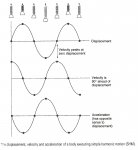One of the questions I have an issue with is :-
“In a Gyroplane with a teetering rotor system in level flight at normal cruise speed, the lift of the advancing blade and the retreating rotor blades is equalised by the process of?”
The correct answer of the multiple choice is given as :-
“C...the advancing blade teeters up, reducing its angle of attack. The retreating blade teeters down, increasing its angle of attack.”
Is this is a deliberate over simplication for us “simpletons” or is it completely correct and I don’t understand the question correctly.
If the advancing blade saw increased airspeed then the increased air pressure would create an upward force on the blade and the reaction due to precessive forces would cause the blade to rise at the front of the gyroplane, not at the RHS, causing a tendency for the Gyroplane to climb which is compensated for the pilot with forward cyclic. It is quite evident when flying that the faster you go the more forward stick you need, such that if your aircraft is fast enough, you can run out of forward stick.
The lift of the advancing and retreating blades is equalised by the pilot using the “cyclic” stick to decrease the pitch on the advancing blade and increase it on the retreating blade, allowing the rotor disc to fly nearly level. This is normally only a few degrees “right” stick, depending on the forward speed, or in most cases the manufacturer would normally adjust the push rods to tilt the head slightly to the right when the stick is centred, to allow the cyclic pitch to change, compensating for the discrepancy in blade airspeed and consequently keeping the angle of the rotor disc nearly level (with a slight tilt left or right to compensate for the torque of the engine, but that is another issue).
In any case, the disc lift vector is perpendicular to the tip plane path of the rotors, meaning that if the advancing blade teetered up and the retreating blade teetered down, the disc would be a tilted to the left, meaning the disc lift vector to be inclined to the left, causing the gyroplane to turn left, and this is not the case in straight and level flight.
in short, the lift of the advancing and retreating blades is equalised by cyclic pitch variation, input by the pilot.

